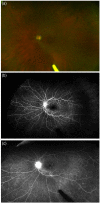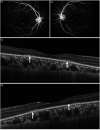Ocular complications of plasma cell dyscrasias
- PMID: 36760117
- PMCID: PMC10472748
- DOI: 10.1177/11206721231155974
Ocular complications of plasma cell dyscrasias
Abstract
Plasma cell dyscrasias are a wide range of severe monoclonal gammopathies caused by pre-malignant or malignant plasma cells that over-secrete an abnormal monoclonal antibody. These disorders are associated with various systemic findings, including ophthalmological disorders. A search of PubMed, EMBASE, Scopus and Cochrane databases was performed in March 2021 to examine evidence pertaining to ocular complications in patients diagnosed with plasma cell dyscrasias. This review outlines the ocular complications associated with smoldering multiple myeloma and monoclonal gammopathy of undetermined significance, plasmacytomas, multiple myeloma, Waldenström's macroglobulinemia, systemic amyloidosis, Polyneuropathy, Organomegaly, Endocrinopathy, Monoclonal gammopathy and Skin changes (POEMS) syndrome, and cryoglobulinemia. Although, the pathological mechanisms are not completely elucidated yet, wide-ranging ocular presentations have been identified over the years, evolving both the anterior and posterior segments of the eye. Moreover, the presenting symptoms also help in early diagnosis in asymptomatic patients. Therefore, it is imperative for the treating ophthalmologist and oncologist to maintain a high clinical suspicion for identifying the ophthalmological signs and diagnosing the underlying disease, preventing its progression through efficacious treatment strategies.
Keywords: CORNEA / EXTERNAL DISEASE; GLAUCOMA; RETINA; Retinal degenerations associated with systemic disease; corneal degenerations.
Figures




Similar articles
-
Neuromuscular disorders associated with paraproteinemia.Phys Med Rehabil Clin N Am. 2008 Feb;19(1):61-79, vi. doi: 10.1016/j.pmr.2007.10.005. Phys Med Rehabil Clin N Am. 2008. PMID: 18194750 Review.
-
Systemic manifestations of monoclonal gammopathy.Eur J Intern Med. 2009 Sep;20(5):457-61. doi: 10.1016/j.ejim.2009.01.001. Epub 2009 Feb 4. Eur J Intern Med. 2009. PMID: 19712843 Review.
-
Review of peripheral neuropathy in plasma cell disorders.Hematol Oncol. 2008 Jun;26(2):55-65. doi: 10.1002/hon.845. Hematol Oncol. 2008. PMID: 18324611 Review.
-
Neurologic aspects of plasma cell disorders.Handb Clin Neurol. 2014;120:1083-99. doi: 10.1016/B978-0-7020-4087-0.00073-5. Handb Clin Neurol. 2014. PMID: 24365373 Review.
-
Plasma cell dyscrasias: current status.Crit Rev Oncol Hematol. 1988;8(2):93-152. doi: 10.1016/s1040-8428(88)80008-8. Crit Rev Oncol Hematol. 1988. PMID: 3046767 Review.
Cited by
-
Urgent and emergent radiotherapy for hematologic malignancies of the central nervous system: a review of the literature and practical approach.Front Oncol. 2025 Mar 31;15:1511261. doi: 10.3389/fonc.2025.1511261. eCollection 2025. Front Oncol. 2025. PMID: 40231259 Free PMC article. Review.
-
Optic Disc Infiltration as a Sign of Multiple Myeloma Recurrence.J Hematol. 2024 Aug;13(4):164-167. doi: 10.14740/jh1267. Epub 2024 Aug 15. J Hematol. 2024. PMID: 39247062 Free PMC article.
-
Retinopathy in a Patient With IgM MGUS: Causal Association or an Epiphenomenon?In Vivo. 2024 Mar-Apr;38(2):954-957. doi: 10.21873/invivo.13526. In Vivo. 2024. PMID: 38418115 Free PMC article.
-
Bilateral exudative retinal detachment with subretinal light-chain protein in a patient with multiple myeloma -case report.BMC Ophthalmol. 2024 Oct 31;24(1):474. doi: 10.1186/s12886-024-03739-5. BMC Ophthalmol. 2024. PMID: 39482581 Free PMC article.
References
-
- Gavriatopoulou M, Musto P, Caers J, et al.. European myeloma network recommendations on diagnosis and management of patients with rare plasma cell dyscrasias. Leukemia. 2018; 32: 1883–1898. - PubMed
-
- Padala SA, Barsouk A, Barsouk A, et al.. Epidemiology, staging, and management of multiple myeloma. Med Sci (Basel, Switzerland) [Internet]. 2021 [cited 2022 Jun 2]; 9: 3. Available from: https://pubmed.ncbi.nlm.nih.gov/33498356/. - PMC - PubMed
-
- Rajkumar SV, Dimopoulos MA, Palumbo A, et al.. International Myeloma Working Group updated criteria for the diagnosis of multiple myeloma. Lancet Oncol. 2014; 15. - PubMed
Publication types
MeSH terms
LinkOut - more resources
Full Text Sources
Medical

